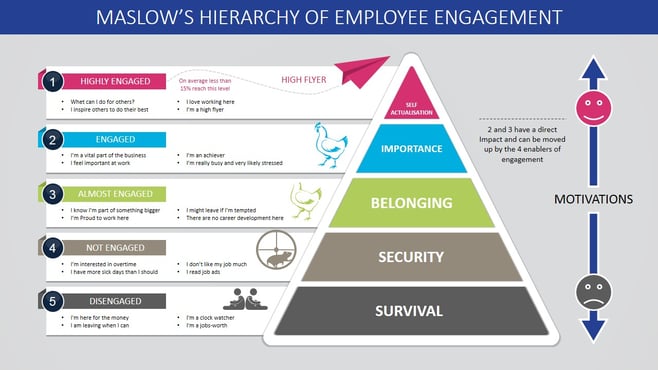If you ever studied Psychology, you probably learned about Maslow’s Hierarchy of Needs. If not, here’s a brief rundown:
The basic idea behind Maslow’s theory is that people will excel in life when their basic needs are met.
The theory is often visually represented as a hierarchical pyramid with 5 levels, or different ‘needs’ (see image below). In order for higher-level needs to be fulfilled and influence behavior, the lower level needs must be satisfied first.
The lowest level of the pyramid includes the basics – food, water, sleep, etc. and moves upwards into more advanced needs like security and belonging.
Maslow’s Hierarchy of Needs theory can be directly applied to how an organization keeps its employees engaged.
We’ve all heard that higher employee engagement positively impacts the success of a company – but how well do we really understand the motivations that drive high employee engagement?
For a lot of people, the basic needs are a job are that the salary lets them pay the bills. Generally speaking, having a sense of financial autonomy is innate in almost all of us. Most people won’t feel comfortable disregarding money in favor of other things.
Moving up the pyramid, employers should consider security.
While we may like to think we are motivated by other factors, after the salary meets their needs, job seekers will then consider if the position is permanent or if there is room for growth.
By nature, we crave stability.
Given the volatility of the job market, most people will be reluctant to take a position they may not be able to keep, or one that has no upward mobility.
Luckily, the majority of organizations recognize the importance of the previously mentioned survival and security needs. It’s the higher-level survival and security needs where employers should be paying closer attention if they want to attract and retain great employees.
The third level of Maslow’s pyramid, is belonging.
We like to feel like we a part of something.
Do your employees know your mission statement? Do they recognize the values of the company? How is your company culture?
Don’t make the mistake of assuming that hiring great people is enough on its own to create a company culture and camaraderie.
The 4th level of Maslow’s pyramid is what really enables an individual to excel in their job and reach the highest level of engagement with an employer – importance.
Your employees should understand that their work matters.
As an employer, are you adequately recognizing your team and meeting their need for importance?
If you’re not sure, consider implementing an employee recognition program
Hint: If you’re not sure how – Check out Employee Recognition and Engagement
Once the needs of survival, security, belonging, and importance have been met - Employees can reach the top of the pyramid: self-actualization
Employees who get to the level of self-actualization are highly engaged and able to reach their full potential. Simply put, they are passionate about what they do.
Reaching this final stage, the emphasis is on what an employee can do for others. Specifically, how they can help the business grow or inspire other people around them.
Interested in learning more about employee engagement or helping your employees reach the top of the pyramid? Check out one of our free resources below!
Back to Blog


Use Maslow's 'Hierarchy of Needs' Theory to Improve Employee Engagement at Your Organization
Mar 11, 2025 1:00:10 PM
By
Leslie Haber

.png?width=2400&name=HQ%20TPD%20careers%20hero%20(1).png)


